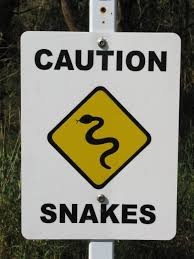
RETRIEVING AUSTRALIA
HOME | ABOUT | FORUM | ARTICLES | ARCHIVE
 Springtime
signals the onset of warmer weather and the end of another a busy
trialling season for most Retrieving enthusiasts. With more clement
conditions and time available it can be tempting to spend more
time outside exercising our dogs and exploring new places for a bit of
training. Unfortunately, this is also when we start to see snakes
about placing dogs and handlers at higher risk of snakebite
injuries.
Springtime
signals the onset of warmer weather and the end of another a busy
trialling season for most Retrieving enthusiasts. With more clement
conditions and time available it can be tempting to spend more
time outside exercising our dogs and exploring new places for a bit of
training. Unfortunately, this is also when we start to see snakes
about placing dogs and handlers at higher risk of snakebite
injuries.| Common or Eastern Brown Snake Pseudonaja textilis The Brown Snake is found all over Australia. Colours vary from dark brown to light orange. This is an agressive snake and has extremely potent venom and causes more snakebite deaths in Australia than any other. Sudden and relatively early deaths have been recorded. Its venom causes severe blood problems which can lead to excesive bleeding and damage to the nevous system, brain and kidneys. The 'Gwardir' is also known as the Western Brown snake, and the 'Dugite' is a spotted brown snake found in Western Australia. All need Brown snake antivenom. | ||
| Taipan Oxyuranus scuttelatus The Taipan is found mostly along the non-desert areas of north and north-east Australia (from Brisbane to Darwin). It is an aggressive, large, slender snake and may be coloured any shade of brown but always has a rectangular head (large in proportion to the body) and red eye. Venom output is high and can cause blood and bleeding problems as well as muscle and kidney damage. Paralysis is difficult to reverse unless treated early. Untreated, a strong bite will almost certainly be fatal. | ||
| Tiger Snake Notechis scutatus The Tiger snake lives in the temperate southern areas of Australia. The characteristic stripes are not seen all year round and there is a totally black variant found around the Flinders Ranges area of South Australia. As well as blood poisoning, muscle and nervous system damage is very likely if treatment is delayed. Untreated mortality is about 45%. | ||
| Death Adder Acanthopis antarcticus The Death Adder has a characteristic appearance and may be striped. It has strongly neurotoxic venom. Blood defects are usually minor and muscle / skeletal damage is almost never seen. Any paralysis is easily reversed by antivenom. | ||
| Copperhead Austrelaps superbus The Copperhead is found in Tasmania, Victoria, and the western plains of NSW. Its venom can cause blood poisoning, nervous system, brain and muscle tissue issues, however, despite its large venom output, bites are rarely fatal. Tiger snake antivenom may be used for treatment. | ||
| Rough Scaled Snake Tropidechis carinatus The Rough Scaled snake is found mostly in northeastern non-arid areas. It may be striped and hence confused with the tiger snake. It is extremely ill-tempered and has venom which can cause blood poisoning, paralyisis and nervous system problems. | ||
| King Brown or Mulga snake Pseudechis australis The King Brown (or Mulga) snake is found in all arid parts of Australia and has the greatest venom output which can cause blood, paralyisis and nervous system problems, but of relatively low toxicity. It has a strongly defined dark crosshatched pattern on its scales and is more related to the black snakes than the brown. King Brown bites require black snake antivenom. | ||
 | Redbellied Black Snake Pseudechis porphyriacus The Redbellied Black snake is found in all eastern non-arid areas. While the venom can cause blood poisoning, paralyisis and nervous system issues it is not as potent as most and no deaths after a Redbellied Black snake have yet been reported. However, be careful as this snake can jump in the air if disturbed or chased. Black or Tiger antivenom may be used. |